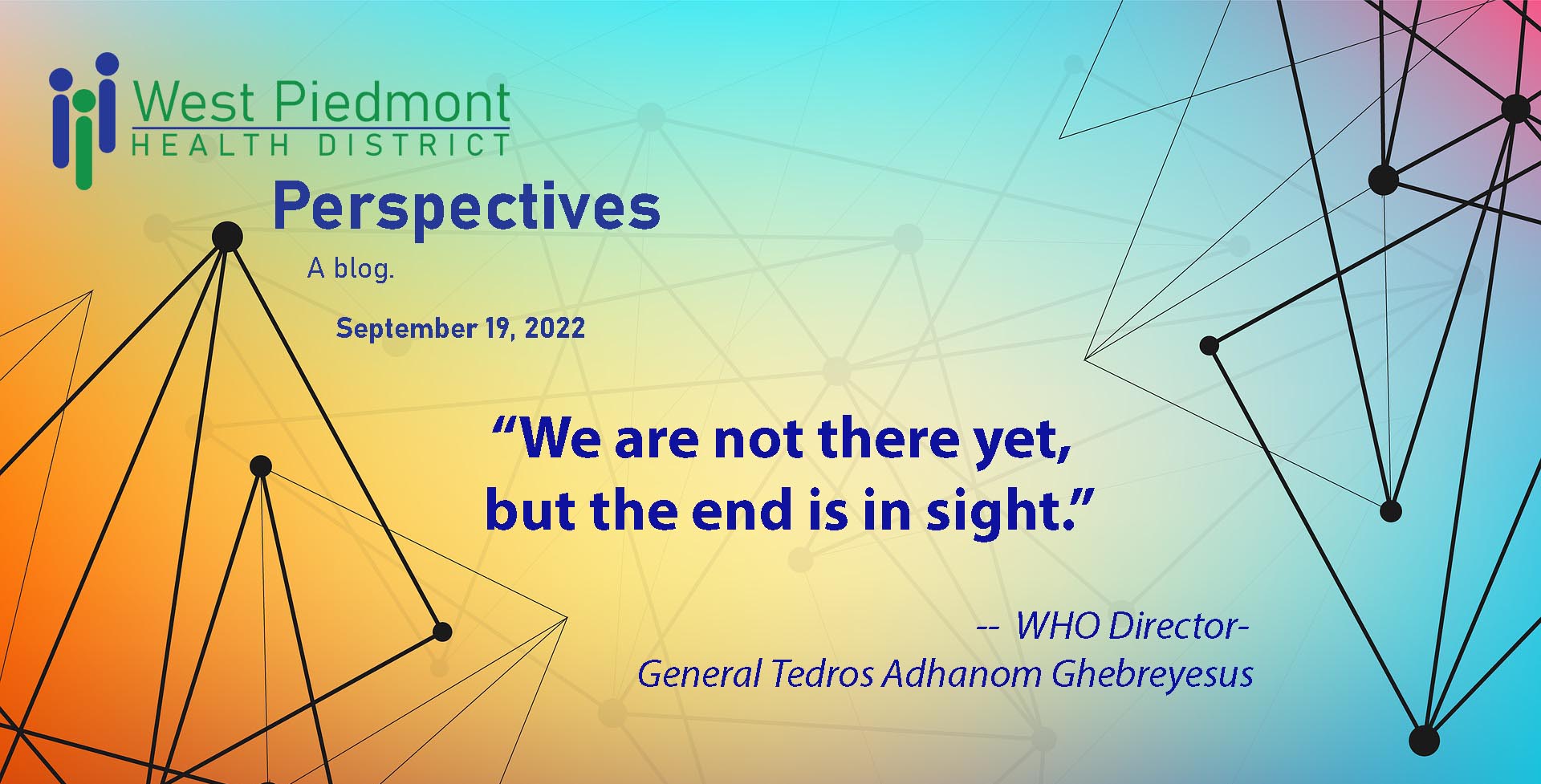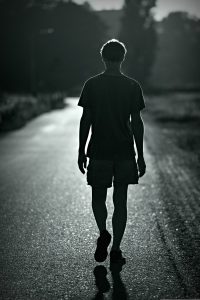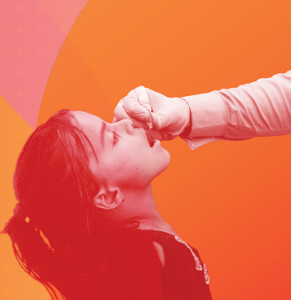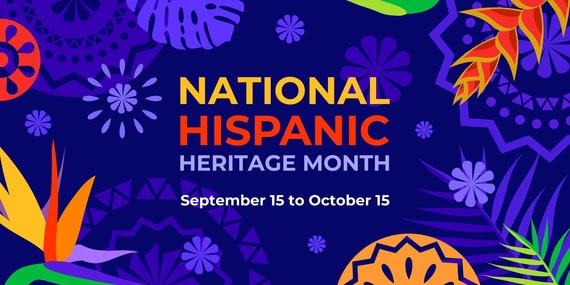
Focus on Facts
- The head of the World Health Organization said (recently) that the number of coronavirus deaths worldwide last week was the lowest reported in the pandemic since March 2020, marking what could be a turning point in the years-long global outbreak. . . . WHO Director-General Tedros Adhanom Ghebreyesus said the world has never been in a better position to stop COVID-19. “We are not there yet, but the end is in sight,” he said, comparing the effort to that made by a marathon runner nearing the finish line. “Now is the worst time to stop running,” he said. “Now is the time to run harder and make sure we cross the line and reap all the rewards of our hard work.” Martinsville Bulletin 9/15/22
- Nationally and globally, there are signs that the pandemic has opened up new vulnerabilities to diseases long in retreat. Routine immunizations have been hindered by a host of obstacles, including COVID-19-related lockdowns and growing vaccine resistance stoked by misinformation and politicization. A recent analysis by UNICEF and the World Health Organization showed that the percentage of children worldwide who received all three doses of the vaccine against diphtheria, tetanus and pertussis — a measure of overall immunization — dropped 5 points between 2019 and 2021 and that measles and polio vaccinations fell, too. The organizations say that’s the largest sustained decline in childhood vaccinations in the roughly 30 years they’ve been collecting data. Propublica Read about it.
- The end of nearly all pandemic-era social-safety-net programs, coupled with skyrocketing inflation for food, rents and fuel, has meant families across the country are struggling to cover basic costs…..The U.S. Agriculture Department announced Wednesday that it is providing close to $2 billion in additional funding to food banks and school meal programs for purchasing American-grown foods. Washington Post 9/14/22
- The virus has killed more than 6.5 million people worldwide and infected more than 611 million. Countries have started rolling back pandemic protocols as daily coronavirus infections have slowed. But health experts caution that public health officials should brace for a potential fall and winter wave of infections. Washington Post 9/16/22
News You Can Use
September is Healthy Aging Month
 Links between COVID-19 and Alzheimer's: People over 65 who contract COVID-19 showed a greater risk of an Alzheimer’s diagnosis within 1 year, according to a study examining electronic health records of more than 6 million Americans. The Washington Post
Links between COVID-19 and Alzheimer's: People over 65 who contract COVID-19 showed a greater risk of an Alzheimer’s diagnosis within 1 year, according to a study examining electronic health records of more than 6 million Americans. The Washington Post- Poor Dental Health Linked to Greater Dementia Risk, Large Review Finds: A healthy mouth may just help keep the brain healthy as well. A study found that poor dental health was linked to a later higher risk of cognitive decline and dementia. This increased risk was especially apparent for those missing some or all of their teeth. . . Ultimately, they found that people with poor oral health were 23% more likely to eventually develop some amount of cognitive decline, and 21% more likely to develop dementia. Gizmodo 9/9/22
- Put on your walking shoes and don’t forget your step counter: You can reduce your risk for cancer, heart disease and early death by getting up to 10,000 steps a day, but any amount of walking helps, according to a new study. Health benefits rose with every step, the study found, but peaked at 10,000 steps – after that the effects faded. Walking 10,000 steps a day lowered risk for dementia by 50%. Risk decreased by 25% with as few as 3,800 steps a day, according to the previous study.. .However, if walking occurred at a brisk pace of 112 steps a minute for 30 minutes, it maximized risk reduction, leading to a 62% reduction in dementia risk. The 30 minutes of fast-paced walking didn’t have to occur all at once, either – it could be spread out over the day. CNN 9/12/22
Equity Tip
Equity in Schools Begins With Changing Mindsets
Cultivating a school climate for equity requires careful attention to the creation of emotional, cognitive, and behavioral spaces throughout the school. It is useful to think of the climate through three lenses (L.S. Shulman, “Signature Pedagogies in the Professions,” 2005):

- Habits of heart—core values; why do you teach?
- Habits of head—ways of thinking and knowing; what do you believe?
- Habits of hand—what you do; how do you practice your values and beliefs?
These habits will be enacted differently through interactions with students versus staff, but for each, the goal is to foster their motivation to perform to the best of their abilities by creating an environment where they want to be, where they see the purpose in being, and where they experience success. An expectancy-value theory of motivation (J. Eccles et al., “Expectancies, Values, and Academic Behaviors,” 1983) offers four suggestions for increasing intrinsic motivation:
- Create a space where people enjoy themselves and can do things that interest them. For students, this means a variety of course options, multiple extracurricular activities, and innovative, hands-on learning experiences. For teachers this may mean variety in teaching assignments, autonomous decision-making, and opportunities to develop new classes.
- Keep your revised equity-focused vision and mission at the core of school functioning. Clearly and consistently communicate your vision and explain how every decision contributes to the realization of the vision. The key here is transparency and honesty when explaining the utility of a particular assignment or class to students, and a new policy to staff.
- Affirm everyone’s contribution to the school community. This could be asking students to facilitate lessons or be peer mentors. You might invite staff to lead an initiative or promote them into a new position.
- Minimize emotional costs by making sure that role expectations are reasonable (i.e., that the outcome will be worth the effort), that they leave time for other enjoyable tasks, and that they do not engender negative emotions. Students and staff should not be given busywork, be overworked, or be asked to do things which they are not capable of doing.
Each of these contributes to a positive school climate because it recognizes and leverages individuality, acknowledges accomplishments, and encourages continual engagement in the school community. School leaders can mistakenly put the climate on autopilot thinking that it will run on its own once people understand their role and are given their scripts. But a school climate is dynamic, open to influence from a variety of sources, so it must be consistently monitored and adjusted. Most importantly, because it is largely people who both shape and are shaped by the school climate, they too must be nurtured.
A new book explores how school leaders can foster equity by building a culture where teachers and students see their purpose and experience success. Public School Equity by Manya Whitaker
~Pamela Chitwood, Population Health Community Coordinator, Pamela.chitwood@vdh.virginia.gov 540-484-0292 ext. 223
The Epi-Center
Epidemiology is the science at center of public health.
 This article points out the importance of keeping up to date on immunizations to help prevent disease outbreaks.
This article points out the importance of keeping up to date on immunizations to help prevent disease outbreaks.
A Polio Primer
Before polio vaccines became available in the 1950s, people wary of the disabling disease were afraid to allow their children outside, let alone go to school. As polio appears again decades after it was considered eliminated in the U.S., Americans unfamiliar with the dreaded disease need a primer on protecting themselves and their young children — many of whom are emerging from the trauma of the covid-19 pandemic.
What is poliomyelitis?
Polio is short for “poliomyelitis,” a neurological disease caused by a poliovirus infection. Of the three types of wild poliovirus — serotypes 1, 2, and 3 — serotype 1 is the most virulent and the most likely to cause paralysis.
Most people infected with poliovirus don’t get sick and won’t have symptoms. About a quarter of those infected might experience mild symptoms like fatigue, fever, headache, neck stiffness, sore throat, nausea, vomiting, and abdominal pain. So, as with covid-19, people who don’t have symptoms can unknowingly spread it as they interact with others. But in up to 1 in 200 people with a poliovirus infection, the virus may attack the spinal cord and brain. When it infects the spinal cord, people may develop muscle weakness or paralysis, including of the legs, arm, or chest wall. Poliovirus may also infect the brain, leading to difficulty breathing or swallowing. . . .
Smallpox is the only human virus to have been declared eradicated to date. A disease may be eradicated if it infects only humans, if viral infection induces long-term immunity to reinfection, and if an effective vaccine or other preventive exists. The more infectious a virus, the more difficult it is to eradicate. Viruses that spread asymptomatically are also more difficult to eradicate. Kaiser Health News 9/16/22
COVID-19 Data
Cases
Over the past 13 weeks by date of illness
Deaths
VA-SORH Photo Contest
The 2022 Virginia State Office of Rural Health (VA-SORH) Photo Contest is designed to showcase the beauty of rural Virginia. The theme of this year’s contest is “Driving Change“. You may interpret the theme however you’d like. Here are some ideas to get you started… rural roads, landmarks, changing leaves, blooming flowers, baby animals, and people in action.
Photographers of all experience levels are encouraged to participate. You may submit as many photos as you’d like.
Winners of the photo contest will be featured in the 2023 VA-SORH Digital Calendar Series and will be announced on November 17th, National Rural Health Day. The deadline to submit your photos is Friday, October 14th. How to submit.

